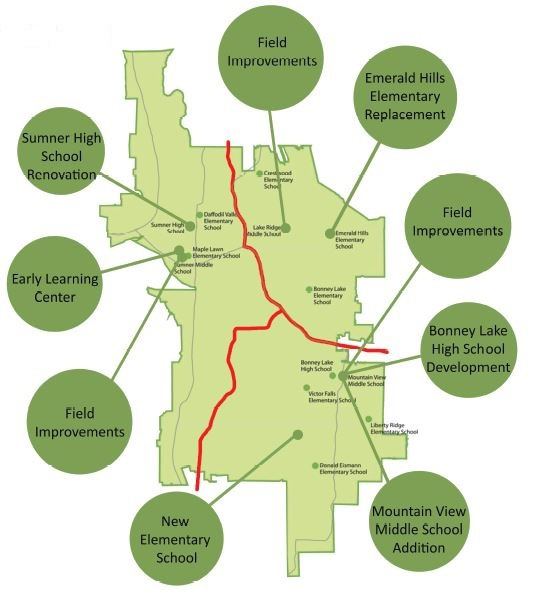Ballots were mailed to voters in the Sumner, White River and Carbonado school districts last week, each asking for millions of dollars and containing promises of improved educational facilities.
Also included in each package was a voters’ pamphlet, explaining what each district plans to do with the money, should the bond measures be approved. Ballots are to be returned by Election Day, Feb. 9.
In each case, it will take a 60 percent show of support for the bond request to be approved.
Here’s rundown of the three local ballot measures.
Sumner School District: what’s proposed
The biggest request is being made by the largest local district, which counts two high schools and three middle schools among its roster of facilities.
According to the official voters’ pamphlet the bond money would: “build a new elementary school and early learning center, replace Emerald Hills Elementary School, expand and modernize Sumner High School, expand Bonney Lake High School and Mountain View Middle School, and make middle school field and District-wide safety and security improvements.”
Bond supporters note that schools in Sumner and Bonney Lake are already exceeding capacity and another 2,000-plus students are anticipated during the next decade.
Sumner School District: financial impacts
The district is asking for $145.6 million to be collected, in the form of property taxes, during a 20-year span.
If passed, property taxes would increase. The district states the tax bump would be about 45 cents for every $1,000 of assessed property value. That means an additional $90 annually on property assessed at $200,000.
For their investment, district patrons are told, the school system anticipates receiving approximately $6.3 million in impact fees due to development, plus an additional $27.7 million from the state.
White River: what’s proposed
The district is seeking nearly $99 million, with collections replacing a current bond that will be paid off at the end of the year. In both cases, the money is generated through property taxes.
According to the Pierce County voters’ pamphlet the bond money would: renovate major portions of Glacier Middle School; renovate and increase capacity at Elk Ridge Elementary; replace the multi-purpose room and kitchen at Wilkeson Elementary; repair and upgrade Foothills Elementary and Mountain Meadow Elementary; constructing a new athletic stadium at White River High School; upgrade community playfields; renovate the library wing at White River Educational Service Center; and upgrading safety, security, technology and equipment in all schools.
White River: financial impacts
The selling point for bond boosters is that district property owners would see no increase in their tax statements. The present rate of $2.80 per $1,000 of assessed property value would remain steady.
If the bond measure were to fail, taxes would decrease with the close of the current year.
Carbonado: what’s proposed
The small district, south of Wilkeson and the last stop before entering the national park, serves students in kindergarten through eighth grade. From there, families can send kids to any district, though most make the trek downhill to White River High.
The district operates on a campus in the middle of town with its historic primary building flanked by portables and a library/technology building. The voters’ pamphlet explains the request for money this way: “The capital improvements being proposed will provide for student safety, increased classroom capacity and an enhanced learning environment, and include: modernization, upgrading and replacement of portions of the Historical School building, installation of a new heating system with back-up generator, upgrading of the building to bring it into ADA compliance, upgrading and modernization of the plumbing and electrical systems, upgrading of four classrooms to be accessible for STEM instruction, energy efficient upgrades to include replacement windows and LED lighting, pavement of parking lot to meet ADA standards and light for evening events, water and sewer line upgrades, and modernization and upgrading of security and life safety systems.”
An intriguing element of the plan involves removal of a concrete ramp that extends across the front of the school and its awning. That would return the school to its original look. Inside, ambitious plans call for dropping the auditorium floor/basketball court by several feet, making it accessible to all.
Carbonado: financial impacts
The bond request asked district property owners to provide $1.75 million, with collections spread over the next 20 years. The collection rate is estimated to be $1.80 per $1,000 of assessed property value; the district uses property assessed at $125,000 as an example, noting the additional tax burden would be $18.75 per month or $225 annually.
This new amount is more than offset, however, by a White River School District bond that Carbonado residents have been contributing to for the past 15 years; that indebtedness will expire at the end of the calendar year. The White River bond has a rate of $2.12, meaning tax payments would decrease.
They would drop even more if the Carbonado request is denied.
Carbonado: an added element
Unlike its neighboring districts, Carbonado will have a second item on the ballot – a traditional maintenance and operation levy.
Unlike bond issues, which pay for facilities, levies are used to provide educational services above and beyond what state funding pays for. The voters pamphlet notes the levy money would be used for “educational programs and services, including teachers, instructional aides, nurses, librarians and other staff, technology support, athletics, arts, music and safety programs, textbooks and other classroom materials, and maintaining playgrounds, playfields and other facilities.”
The four-year proposal is billed as a replacement, picking up where an M&O levy passed four years ago leaves off. If approved, collections will range from $583,000 next year to $619,000 in 2019. The levy rate would be fairly steady during the 48 months, ranging between $7.21 and $7.24 per $1,000 of assessed property value.
If the M&O levy fails, tax rates would drop accordingly.


